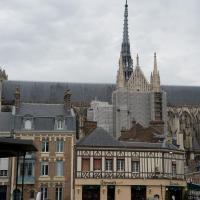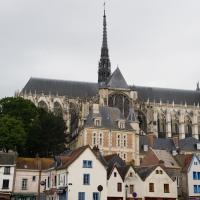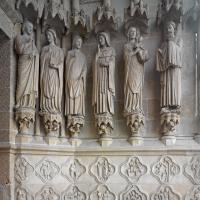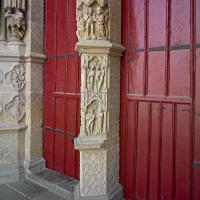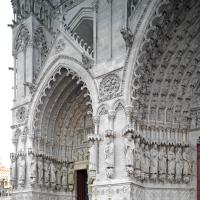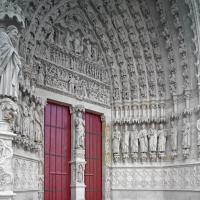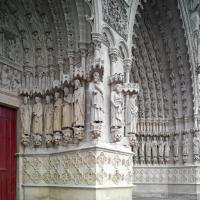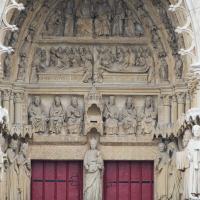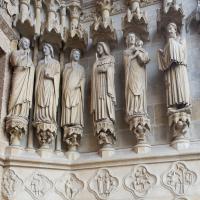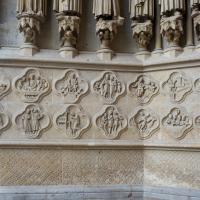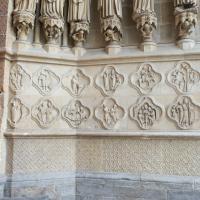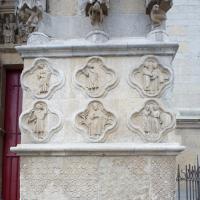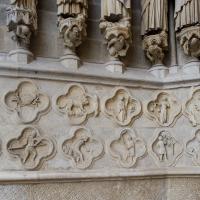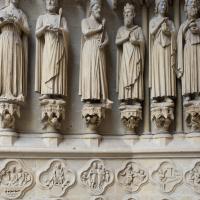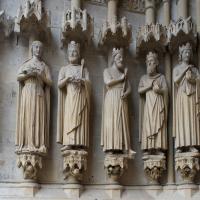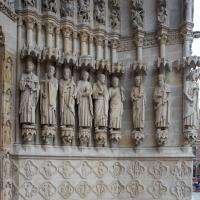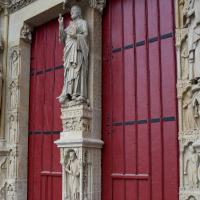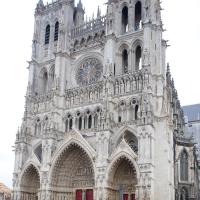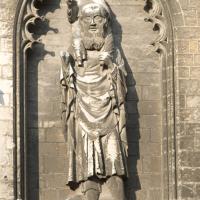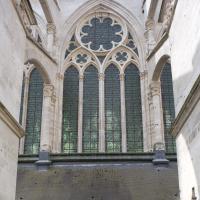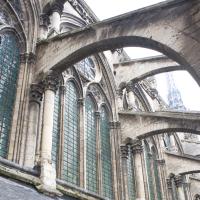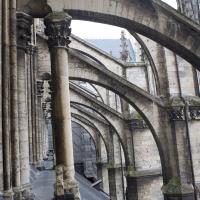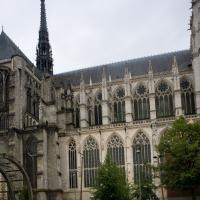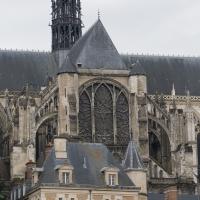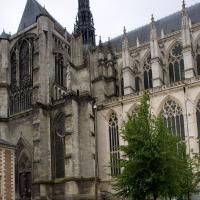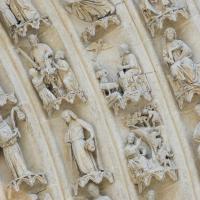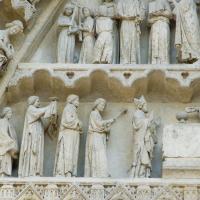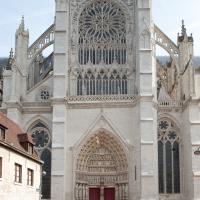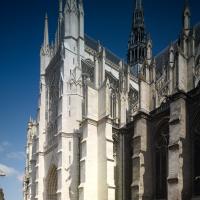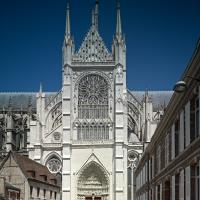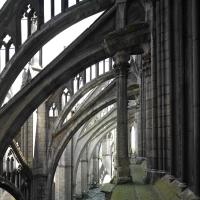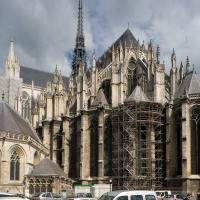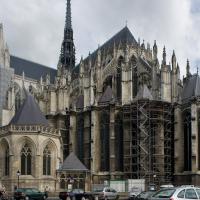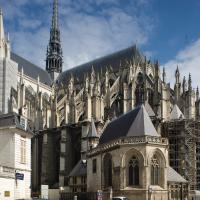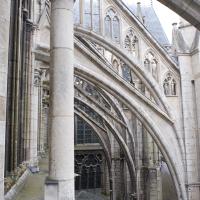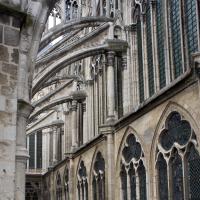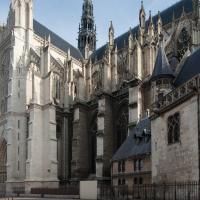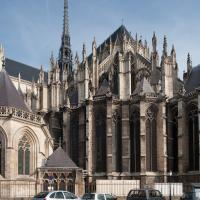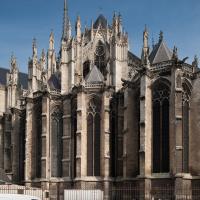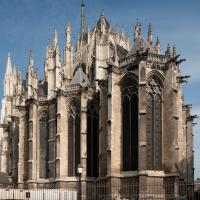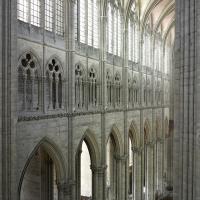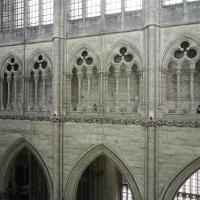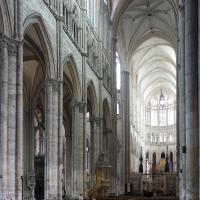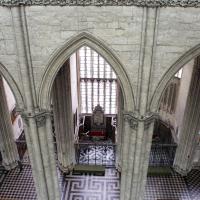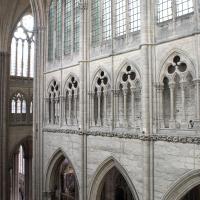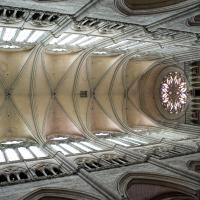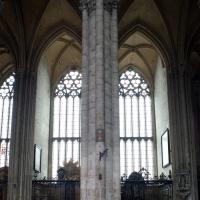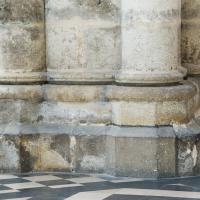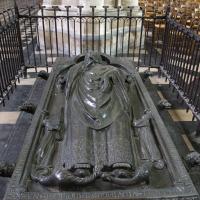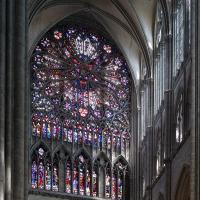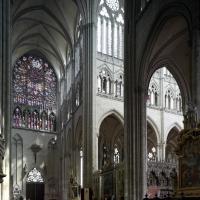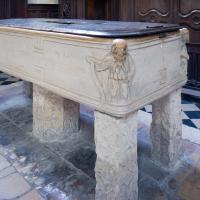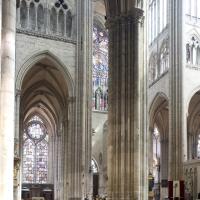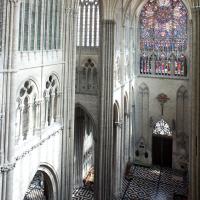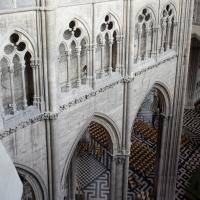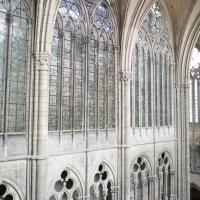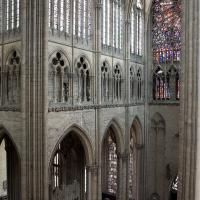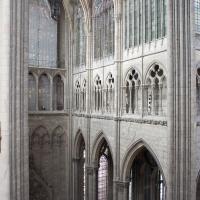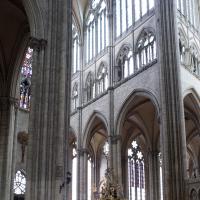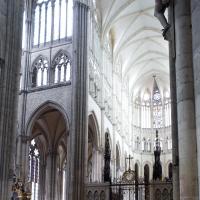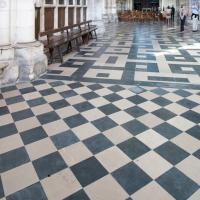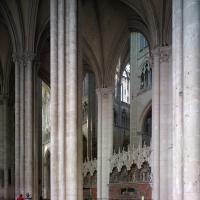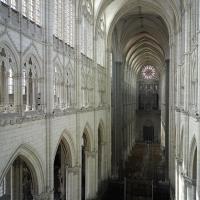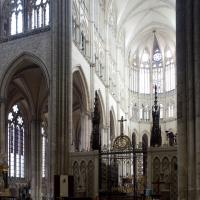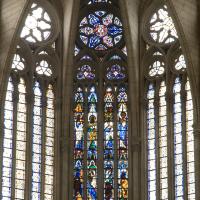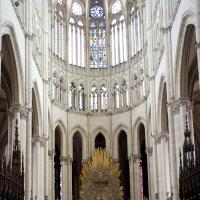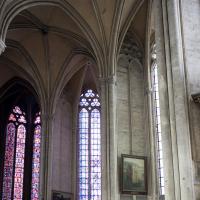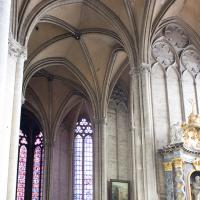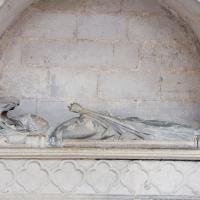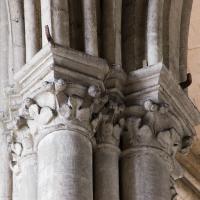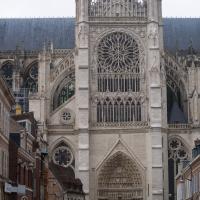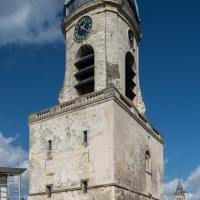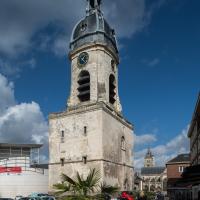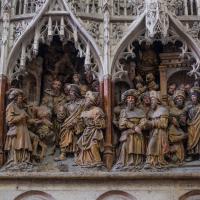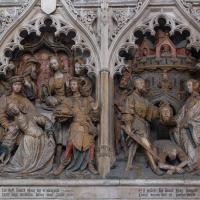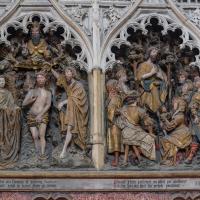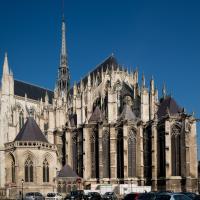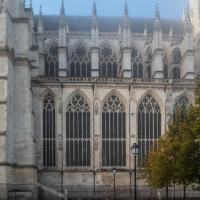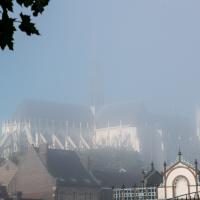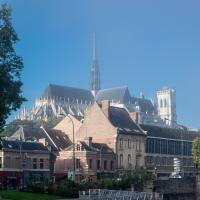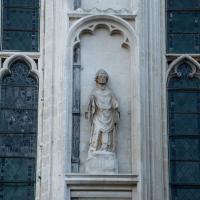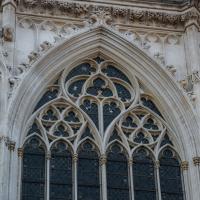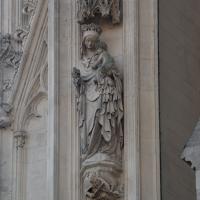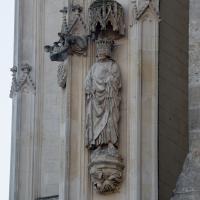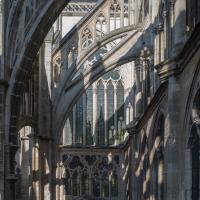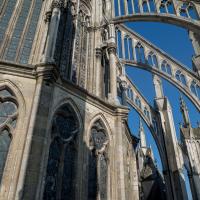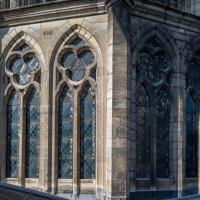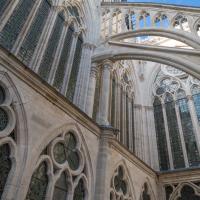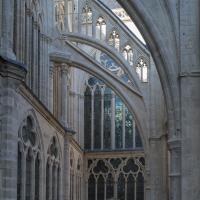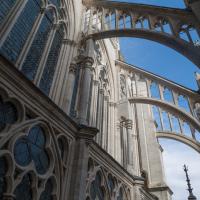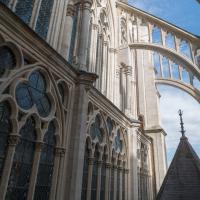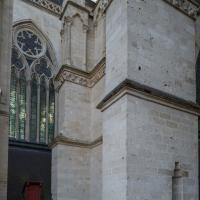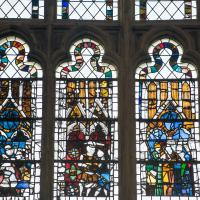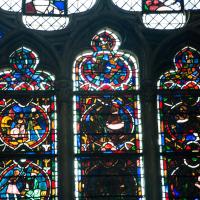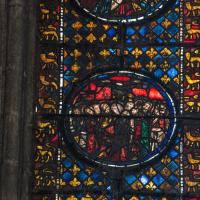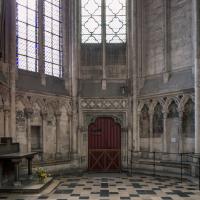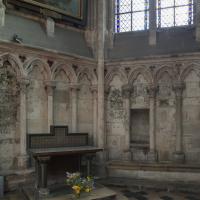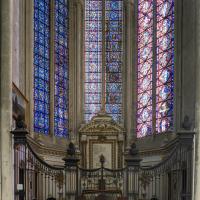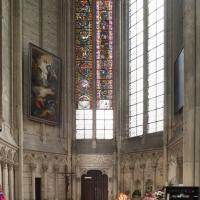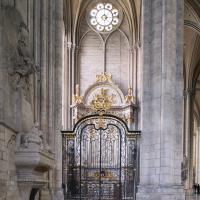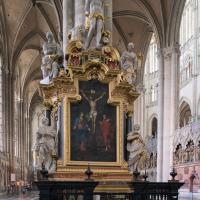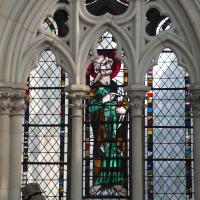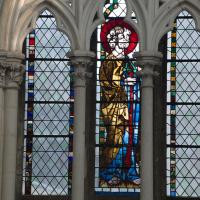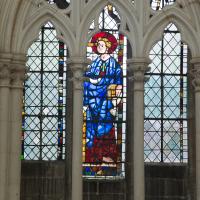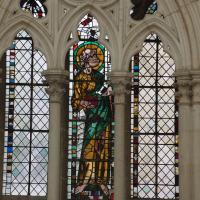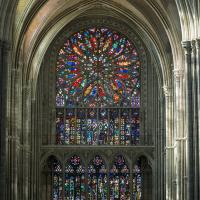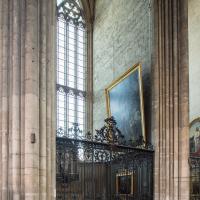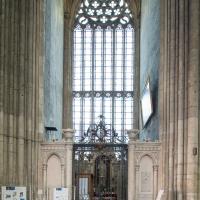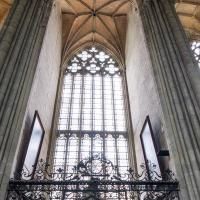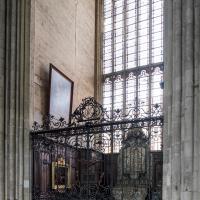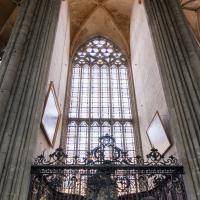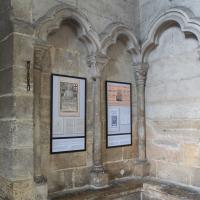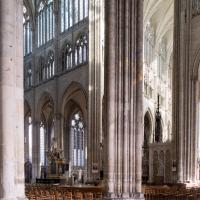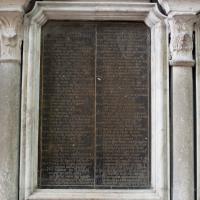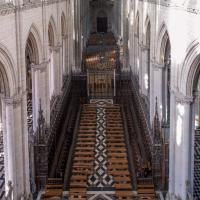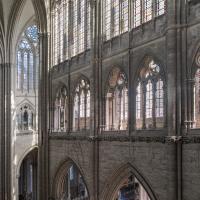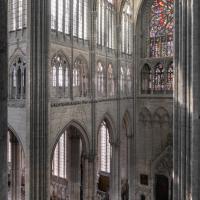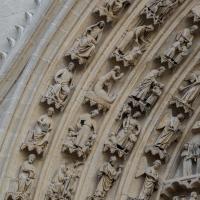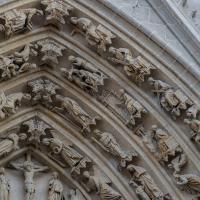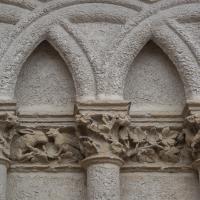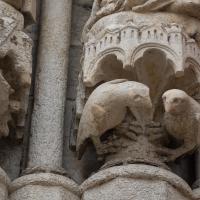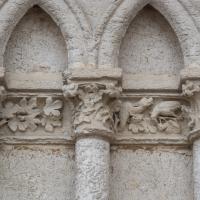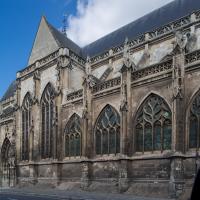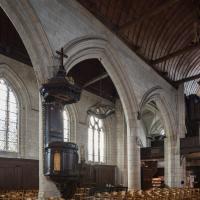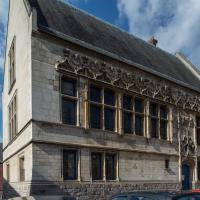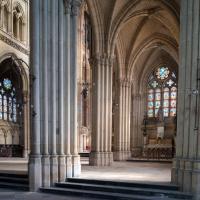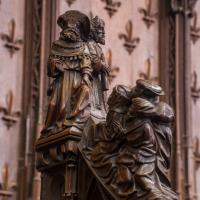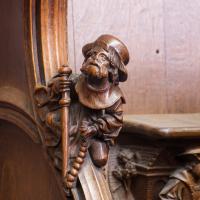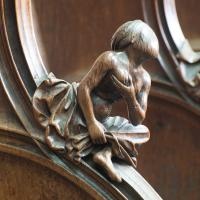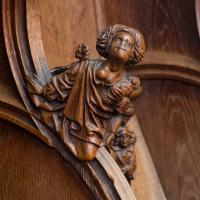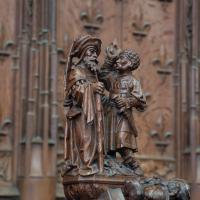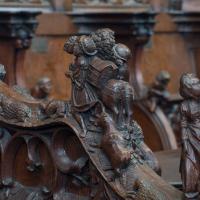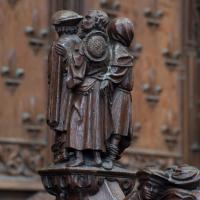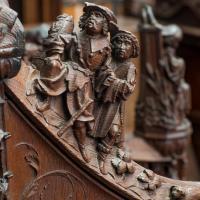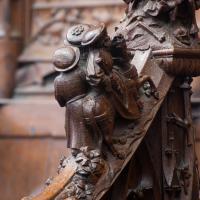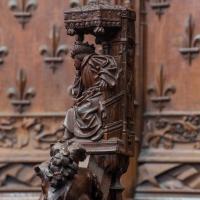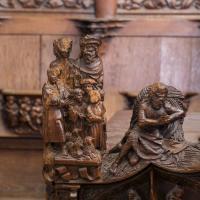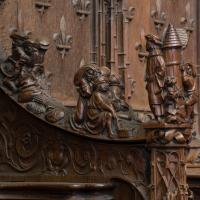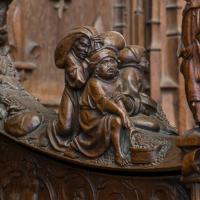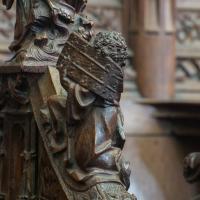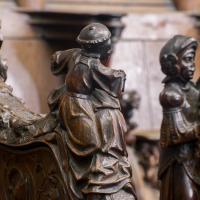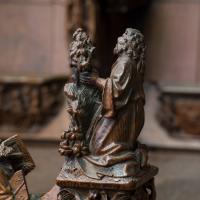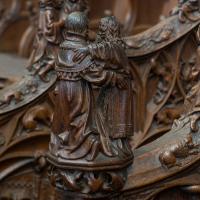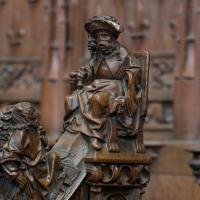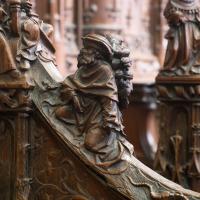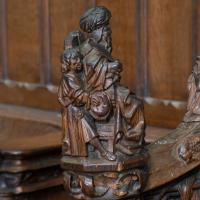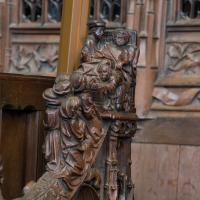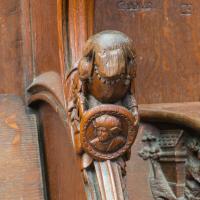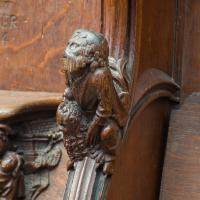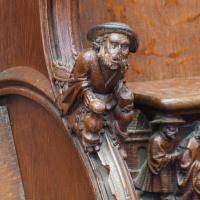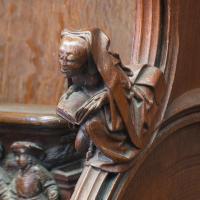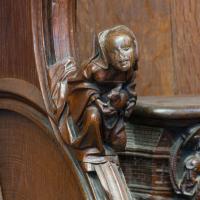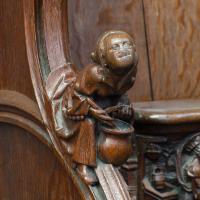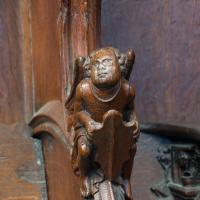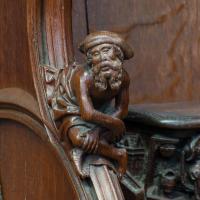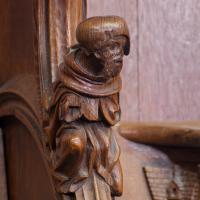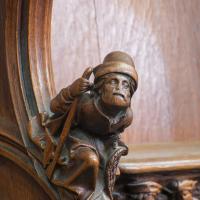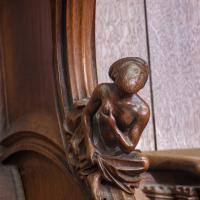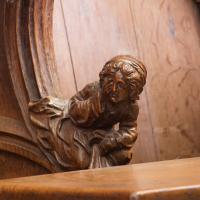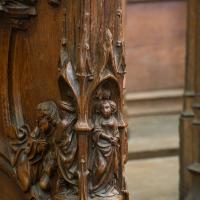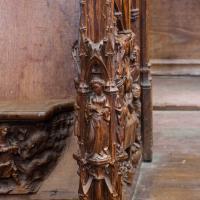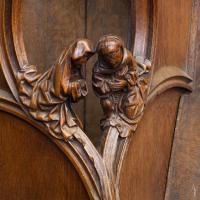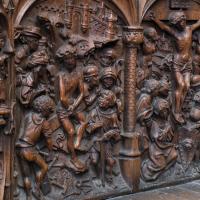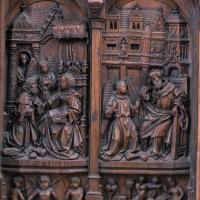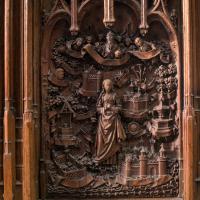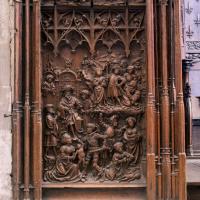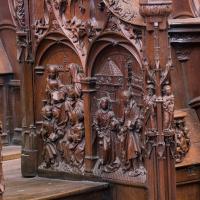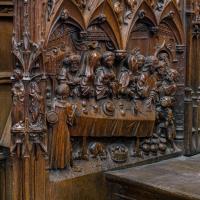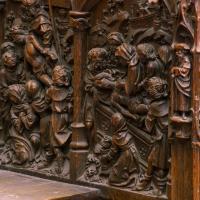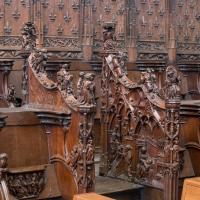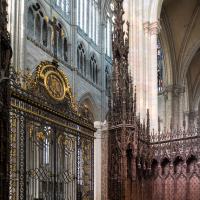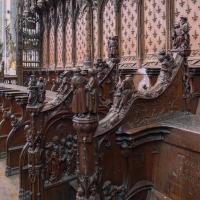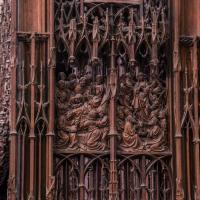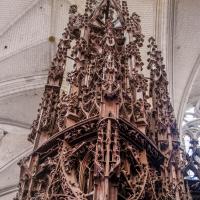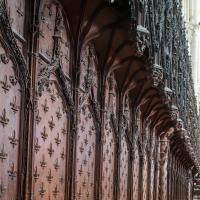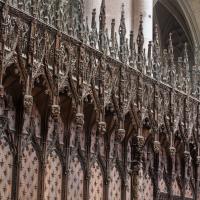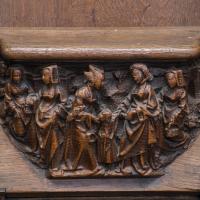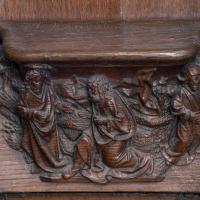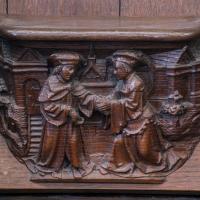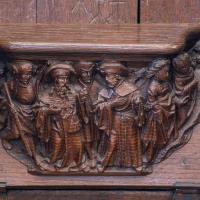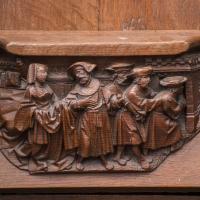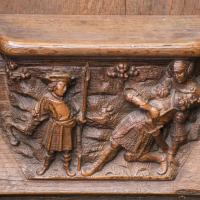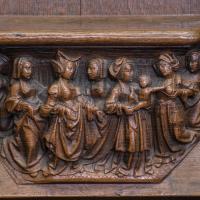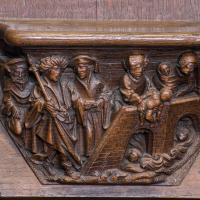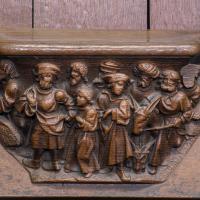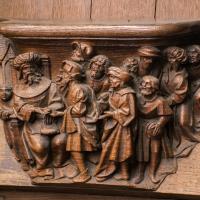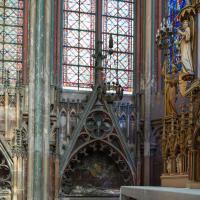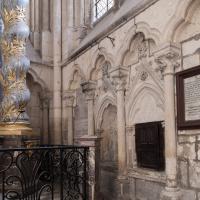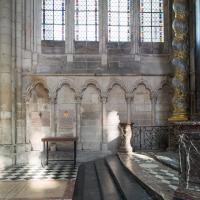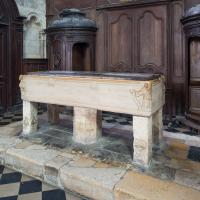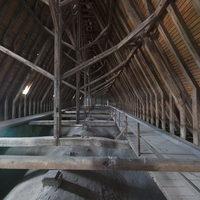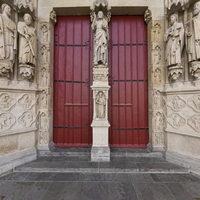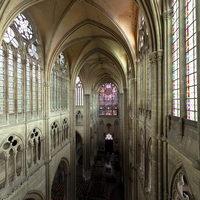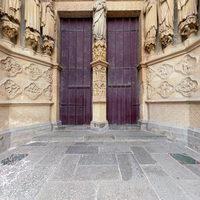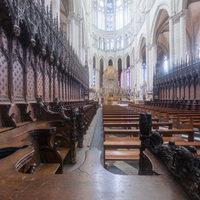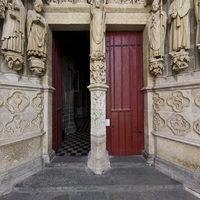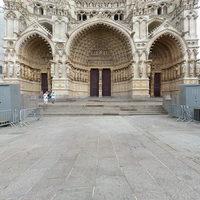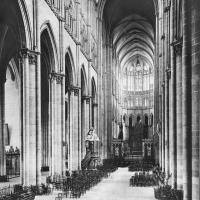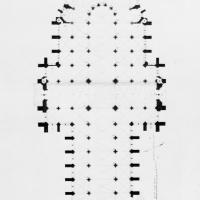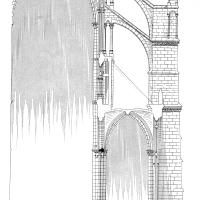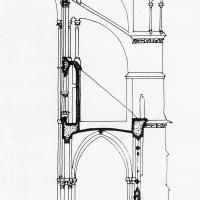Images
VR Tour
Notes
Date
Begun 1220
Plan
This is a basilica where a five aisled choir and a three aisled nave is intersected by an aisled transept of shallow projection. The seven segment hemicycle is encircled by a single aisled ambulatory with seven radiating chapels, the axial chapel projecting more deeply than the others. To the west a frontispiece of unusual design embodies tower supporting masonry in the western bay of the nave carrying two rectangular towers. The plan is rigorously controlled by a central geometric matrix in the form of a great double square located in the crossing and contiguous bay. The diagonal of the great square gives the length of the nave and the half diagonal gives the choir.
Elevation
The cathedral has a three story elevation: spacious arcade capped by a prominent foliate band, a blind triforium in the nave and glazed in the choir and a tall clerestory. With a height of some forty-two meters the vertical space is divided into two equal parts by the foliage band.
Chronology
Work started in the center of the building in 1220 with the south nave aisle and southwest transept aisle going up ahead of the equivalent aisled of the north. The lower walls of the choir straight bays up to the window sills were laid out at the same time. The western frontispiece was begun in 1225 and the lower nave completed by the 1230's under the direction of Robert de Luzarches. Thomas de Cormont completed the upper nave in the 1240's and later the radiating chapels. Finally in the 1250's and 60's Renaud de Cormont completed the upper east transept arm and the upper choir introducing radical changes and modifications including the glazed triforium and openwork buttresses. Late gothic work on the cathedral includes the addition of nave chapels, completion and west towers and radical structural intervention.
Sculptural Program
The western frontispiece of Amiens cathedral displays a program of three sculpted portals. The south portal addresses the theme of the Virgin Mary as Mother of God. The lowest register of the lintel depicts six Old Testament patriarchs flanking the trumeau canopy, which contains a representation of the Ark of the Covenant. Only Moses, who carries the tablets of the law to the left of the canopy, and Aaron, who carries a flowering rod and wears a diadem to the right of the canopy, are identified.
The next register shows the Virgin Mary's Dormition on the left, and her Assumption on the right. The typanum depicts the Coronation of the Virgin. She is seated to Christ's left, and angels place a crown on her head from above. Christ and the Virgin are flanked by angels carrying tapers and censers. This portal contains three bands of voussoirs. The inner band depicts angels carrying liturgical instruments. The outer two bands depict the kings of the Tree of Jesse.
The trumeau figure is of the Virgin Mary carrying the Christ Child. The jamb figures, beginning on the left exterior, are identified as the Queen of Sheba, King Solomon, Herod, and the Three Magi. On the right side of the portal, beginning with the interior, are shown the Annunciation, with the Angel Gabriel and Mary each occupying their own column, followed by the Visitation, with Mary and St. Elizabeth on their own columns, and finally the Presentation in the Temple, with Mary with the Christ Child and Simeon on their proper columns.
Below the column figures, the quatrefoil embrasures depict, on the left side from exterior to interior Sheba and Solomon, the Massacre of the Innocents, and the Journey of the Three Magi, while on the right, from interior to exterior, are shown the stories of Gideon's fleece, the burning bush, Aaron's flowering rod, the history of Zacharias and Elizabeth, and idols falling from their stands during the Flight to Egypt.
The north portal explores the theme of St. Firmin and other local saints. The lowest register of the lintel depicts six seated bishops, three on each side of the trumeau canopy, which resembles a reliquary chasse. Two of the figures hold croziers, representing the bishop's duties as priest. Two hold books, representing their role as teachers, and two hold staffs, representing their role as administrators. The next register depicts the invention of the relics of St. Firmin, first bishop of Amiens, by St. Salve, bishop of Amiens in the sixth century. He is flanked on either side by representations of the people of the four neighboring towns (Beauvais, Cambrai, Noyon, and Thérouanne) who were drawn to witness the invention by the sweet odor of the remains. In the tympanum, the chasse containing the remains of St. Firmin is being carried to the church by monks. They are escorted by monks and altar boys carrying liturgical instruments, and are eagerly awaited by a crowd of people who peer from architectural frames and climb verdant trees to get a better view. Angels with censers appear above the group. They are followed by a man with a laurel crown who has removed his jacket and carries it on a stick behind him. This is "l'homme vert," and his presence reminds viewers of the miracle that occurred at the discovery of St. Firmin's remains. Though it was the dead of winter, the weather became unbearably hot and all the trees and flowers bloomed for several hours. There are three bands of voussoirs. The inner band depicts angels holding crowns, with a seated figure of a bishop at the base of each side and a figure of Christ crowned at the center. The second band depicts angels holding tapers, with a head of God the Father at the center. The outer band depicts angels swinging censers.
The trumeau figure on the north portal is that of St. Firmin in bishop's garb. The jamb figures are, on the left side from exterior to interior St. Ulphe, an angel with scroll, two cephalophores (possibly local saints Ache and Acheul), another angel with censer, and a bishop (possibly St. Honoré, another local bishop). The right jambs depict, from interior to exterior, a bishop (possibly St. Firmin the Confessor, a bishop who erected a church on the site of St. Firmin the Martyr's tomb), a deacon (probably Domice, companion of St. Ulphe), another bishop (possibly St. Salve, the bishop who discovered St. Firmin's relics), and three saints (possibly Fuscien, Victoric, and Gentien, martyrs whose remains were discovered by St. Honoré). The embrasures below show the labors of the month on the lower register and the signs of the zodiac on the upper register.
The central portal is eschatological, showing a scene of the Last Judgment. The lowest register of the lintel shows, in the center, Michael weighing souls. The left side of the balance holds a lamb, the right a demon's head. A demon below the right side interferes with the scale. A figure of Ecclesia sits below the lamb, Synagoga below the demon's head. To the left and right, the dead rise from their tombs, flanked by a trumpeting angel. The lintel is framed on top and bottom by a foliate band. The second register shows saved souls on the left being ushered into Heaven, while on the right damned souls are being thrown into the Hellmouth. Above the saved souls are angels bearing crowns. Above the damned souls are angels wielding flaming swords. On the tympanum, Christ sits in judgment below an architectural canopy. The Virgin Mary kneels to his left, and John the Evangelist to his right. Flanking them are angels carrying the instruments of the passion. Above the canopy, two angels carry representations of the sun and moon, and in the center is the image of Christ at the Second Coming, with two swords issuing from his mouth and a scroll in either hand.
There are eight bands of voussoirs. The lowest register of each band shows, on the left, angels with saved souls, and on the right, damned souls tortured by demons, some on horseback. The first band shows angels with hands folded in prayer. The second band shows angel with saved souls in their arms. Then come martyrs, confessors, virgins, apocalyptic elders, a Tree of Jesse and patriarchs of the Old Testament.
The trumeau figure on the central portal is a figure of Christ known as the Beau Dieu, seen trampling the lion and the serpent. Either David or Solomon is depicted on the aedicule below the trumeau. The doorframe to the left of the portal depicts the Wise Virgins, and the frame to the right depicts the Foolish Virgins. The jamb figures on the left, from exterior to interior, are clearly Apostles, though only the interior-most figure is identified as Paul. The right, from interior to exterior, shows Peter, an unidentified apostle, James the Greater, John the Evangelist, and other unidentified apostles. The embrasures below depict, on the lower register, the Vices, and on the upper register the Virtues.
The front face of the four buttresses on the west façade show figures of prophets, from right to left: Hosea, Joel, Amos, Obadaiah, Jonah, Micah, Nahum, Habakkuk, Zephanaiah, Haggai, Zecharaiah and Malachi. The quatrefoils in the embrasures below show scenes from the Old Testament.
The western portals of Amiens are dated to circa 1225-1240, and is considered one of the highest achievements of planned sculptural programs in the Gothic era. The sculptural program of the west façade mirrors the rhetorical structure of a sermon. The prophets, who are the voices of God and speak of the future, invite us to listen to the message of the portals. In the center, we are shown the terrifying power of Christ to determine the fate of humanity. We can live a good life free of sin, as did the Apostles, and then we will see the benevolence of the Beau Dieu. If we live badly, we will suffer the torments of hell and the wrath of Christ at his Second Coming. The two flanking portals give viewers concrete pathways to salvation. The structure of these two portals mirror each other formally, with the apostles on the lintel of Mary's portal corresponding to the bishops on Firmin's portal, and the Dormition, Assumption, and Coronation of the Virgin mirroring the invention and translation of St. Firmin's relics. Thus, the Virgin Mary, as bride and mother of Christ, provides one means of intercession. The other means can be found in the fabric of the Church, and more specifically in the local saints whose relics are displayed there. It is a highly unified and planned program. It is likely that the dean of the Amiens chapter during this phase of construction, Jean d'Abbeville, had a large hand in the planning of the sculptural program. He was highly educated, and a well-respected for his sermons which attempted to reach a wide variety of audiences. So, too, do the portals of the west façade.
Stylistically, the figures on the west façade are Antique Revival, though somewhat simplified. Some have even called the sculptures "lifeless and inert," given their serene faces, shallow but elegant drapery, and simple, repetitive stances and gestures. The figures seem almost entirely emancipated from the columns behind. Stylistically and thematically, Amiens refers to both the west façade of Notre-Dame at Paris and the transept portals of Chartres Cathedral, however here the program is expanded and refined to an unprecedented degree.
The south transept portal of Amiens also displays a refined sculptural program addressing the life and miracles of St. Honoré. The lowest register of the lintel depicts the twelve apostles. The next register depicts the miraculous effluence of holy oil anointing St. Honoré as bishop of Amiens to the far left. A cluster of clergy members discuss the miracle to the right. In the center stands an altar with chalice and screen. To the right of the altar sits St. Honoré, below a canopy signifying Ecclesia, with his hand on a book. He looks up from reading to hear of the discovery of three saints, Fuscien, Victoric, and Gentien, whose invention is depicted at the far right. Here, as with the invention of St. Firmin's relics, trees burst into bloom. The third register shows, to the left, St. Honoré performing mass, flanked by attendants carrying liturgical instruments. On the altar where mass is being performed, the hand of God can be seen blessing the Sacrament, referencing a miracle associated with the saint. On the right, a statue of the saint sits on an altar, and a blind woman is healed by touching her eyes to the altar cloth. Behind her another figure with a cane is waiting to be healed. The fourth register shows a procession of St. Honoré's reliquary chasse. It is carried on the shoulders of monks, and below it three people with various afflictions touch the casket, hoping for miraculous healing. A monk to the left carries an arm reliquary, and other clergy members and altar boys carry various books and liturgical instruments. On the right, a crowd gathers to witness the procession. On the tympanum, Christ is shown on the cross flanked by the Virgin Mary and John the Evangelist and two angels with censers. This refers to the miracle during which a rood crucifix in a neighboring church supposedly inclined its head towards St. Honoré's relics as they were being processed through the church.
The portal also has four bands of voussoirs showing angels with censers, precursors of Christ, major and minor prophets, and finally Apostles and holy women. The trumeau figure of this portal is known as the Vierge Dorée ("the Golden Virgin"), and is a graceful Virgin and Child done in the later "beautiful style" associated with portal sculpture at Reims cathedral. The jamb figures of this portal were most likely recycled figures left over from an earlier campaign on the west frontispiece. The outer figures on both sides are angels, and the rest consist of unidentified ecclesiastic figures holding liturgical instruments. Their style and proportions are very different from the rest of the program, which indicates a different era or workshop of production.
Besides these recycled jamb figures, the rest of the program dates to after 1240. In 1240, the clergy of Amiens staged a relic quest to raise funds for the fabric of the cathedral. They processed the relics of St. Honoré to villages throughout the diocese. This portal was likely sculpted around this time to increase the prominence of the miracles associated with the saint, and make donations on his behalf more appealing. Stylistically, the tympanum figures are more lively and refined than the figures on the west façade, with animated expressions and poses. They seem linked to the most refined figures on the façade of Notre-Dame at Paris, where the highly praised "court style" was beginning to be developed. It is possible that the workshop responsible for this portal was a satellite of a workshop at Notre-Dame de Paris. Thematically, the St. Honoré portal refers to the Calixtus portal at Reims Cathedral, which also describes the life and miracles of a celebrated local saint.
Significance
Notre-Dame of Amiens is by far the tallest cathedral built at this time with a new level of rigor and an attention to form drawing upon masonic expertise from the Soissonais. This is important in marking the extension of Royal power beyond the Ile-de-France and into Picardy. Choices made in the architecture reflect the preferences of the King of France. In the struggles between the king and the secular clergy in the 1230's the city sided with the King. So in a sense Amiens can be seen as a royal city.


